10.1: Animals
- Page ID
- 1390
\( \newcommand{\vecs}[1]{\overset { \scriptstyle \rightharpoonup} {\mathbf{#1}} } \)
\( \newcommand{\vecd}[1]{\overset{-\!-\!\rightharpoonup}{\vphantom{a}\smash {#1}}} \)
\( \newcommand{\dsum}{\displaystyle\sum\limits} \)
\( \newcommand{\dint}{\displaystyle\int\limits} \)
\( \newcommand{\dlim}{\displaystyle\lim\limits} \)
\( \newcommand{\id}{\mathrm{id}}\) \( \newcommand{\Span}{\mathrm{span}}\)
( \newcommand{\kernel}{\mathrm{null}\,}\) \( \newcommand{\range}{\mathrm{range}\,}\)
\( \newcommand{\RealPart}{\mathrm{Re}}\) \( \newcommand{\ImaginaryPart}{\mathrm{Im}}\)
\( \newcommand{\Argument}{\mathrm{Arg}}\) \( \newcommand{\norm}[1]{\| #1 \|}\)
\( \newcommand{\inner}[2]{\langle #1, #2 \rangle}\)
\( \newcommand{\Span}{\mathrm{span}}\)
\( \newcommand{\id}{\mathrm{id}}\)
\( \newcommand{\Span}{\mathrm{span}}\)
\( \newcommand{\kernel}{\mathrm{null}\,}\)
\( \newcommand{\range}{\mathrm{range}\,}\)
\( \newcommand{\RealPart}{\mathrm{Re}}\)
\( \newcommand{\ImaginaryPart}{\mathrm{Im}}\)
\( \newcommand{\Argument}{\mathrm{Arg}}\)
\( \newcommand{\norm}[1]{\| #1 \|}\)
\( \newcommand{\inner}[2]{\langle #1, #2 \rangle}\)
\( \newcommand{\Span}{\mathrm{span}}\) \( \newcommand{\AA}{\unicode[.8,0]{x212B}}\)
\( \newcommand{\vectorA}[1]{\vec{#1}} % arrow\)
\( \newcommand{\vectorAt}[1]{\vec{\text{#1}}} % arrow\)
\( \newcommand{\vectorB}[1]{\overset { \scriptstyle \rightharpoonup} {\mathbf{#1}} } \)
\( \newcommand{\vectorC}[1]{\textbf{#1}} \)
\( \newcommand{\vectorD}[1]{\overrightarrow{#1}} \)
\( \newcommand{\vectorDt}[1]{\overrightarrow{\text{#1}}} \)
\( \newcommand{\vectE}[1]{\overset{-\!-\!\rightharpoonup}{\vphantom{a}\smash{\mathbf {#1}}}} \)
\( \newcommand{\vecs}[1]{\overset { \scriptstyle \rightharpoonup} {\mathbf{#1}} } \)
\( \newcommand{\vecd}[1]{\overset{-\!-\!\rightharpoonup}{\vphantom{a}\smash {#1}}} \)
\(\newcommand{\avec}{\mathbf a}\) \(\newcommand{\bvec}{\mathbf b}\) \(\newcommand{\cvec}{\mathbf c}\) \(\newcommand{\dvec}{\mathbf d}\) \(\newcommand{\dtil}{\widetilde{\mathbf d}}\) \(\newcommand{\evec}{\mathbf e}\) \(\newcommand{\fvec}{\mathbf f}\) \(\newcommand{\nvec}{\mathbf n}\) \(\newcommand{\pvec}{\mathbf p}\) \(\newcommand{\qvec}{\mathbf q}\) \(\newcommand{\svec}{\mathbf s}\) \(\newcommand{\tvec}{\mathbf t}\) \(\newcommand{\uvec}{\mathbf u}\) \(\newcommand{\vvec}{\mathbf v}\) \(\newcommand{\wvec}{\mathbf w}\) \(\newcommand{\xvec}{\mathbf x}\) \(\newcommand{\yvec}{\mathbf y}\) \(\newcommand{\zvec}{\mathbf z}\) \(\newcommand{\rvec}{\mathbf r}\) \(\newcommand{\mvec}{\mathbf m}\) \(\newcommand{\zerovec}{\mathbf 0}\) \(\newcommand{\onevec}{\mathbf 1}\) \(\newcommand{\real}{\mathbb R}\) \(\newcommand{\twovec}[2]{\left[\begin{array}{r}#1 \\ #2 \end{array}\right]}\) \(\newcommand{\ctwovec}[2]{\left[\begin{array}{c}#1 \\ #2 \end{array}\right]}\) \(\newcommand{\threevec}[3]{\left[\begin{array}{r}#1 \\ #2 \\ #3 \end{array}\right]}\) \(\newcommand{\cthreevec}[3]{\left[\begin{array}{c}#1 \\ #2 \\ #3 \end{array}\right]}\) \(\newcommand{\fourvec}[4]{\left[\begin{array}{r}#1 \\ #2 \\ #3 \\ #4 \end{array}\right]}\) \(\newcommand{\cfourvec}[4]{\left[\begin{array}{c}#1 \\ #2 \\ #3 \\ #4 \end{array}\right]}\) \(\newcommand{\fivevec}[5]{\left[\begin{array}{r}#1 \\ #2 \\ #3 \\ #4 \\ #5 \\ \end{array}\right]}\) \(\newcommand{\cfivevec}[5]{\left[\begin{array}{c}#1 \\ #2 \\ #3 \\ #4 \\ #5 \\ \end{array}\right]}\) \(\newcommand{\mattwo}[4]{\left[\begin{array}{rr}#1 \amp #2 \\ #3 \amp #4 \\ \end{array}\right]}\) \(\newcommand{\laspan}[1]{\text{Span}\{#1\}}\) \(\newcommand{\bcal}{\cal B}\) \(\newcommand{\ccal}{\cal C}\) \(\newcommand{\scal}{\cal S}\) \(\newcommand{\wcal}{\cal W}\) \(\newcommand{\ecal}{\cal E}\) \(\newcommand{\coords}[2]{\left\{#1\right\}_{#2}}\) \(\newcommand{\gray}[1]{\color{gray}{#1}}\) \(\newcommand{\lgray}[1]{\color{lightgray}{#1}}\) \(\newcommand{\rank}{\operatorname{rank}}\) \(\newcommand{\row}{\text{Row}}\) \(\newcommand{\col}{\text{Col}}\) \(\renewcommand{\row}{\text{Row}}\) \(\newcommand{\nul}{\text{Nul}}\) \(\newcommand{\var}{\text{Var}}\) \(\newcommand{\corr}{\text{corr}}\) \(\newcommand{\len}[1]{\left|#1\right|}\) \(\newcommand{\bbar}{\overline{\bvec}}\) \(\newcommand{\bhat}{\widehat{\bvec}}\) \(\newcommand{\bperp}{\bvec^\perp}\) \(\newcommand{\xhat}{\widehat{\xvec}}\) \(\newcommand{\vhat}{\widehat{\vvec}}\) \(\newcommand{\uhat}{\widehat{\uvec}}\) \(\newcommand{\what}{\widehat{\wvec}}\) \(\newcommand{\Sighat}{\widehat{\Sigma}}\) \(\newcommand{\lt}{<}\) \(\newcommand{\gt}{>}\) \(\newcommand{\amp}{&}\) \(\definecolor{fillinmathshade}{gray}{0.9}\)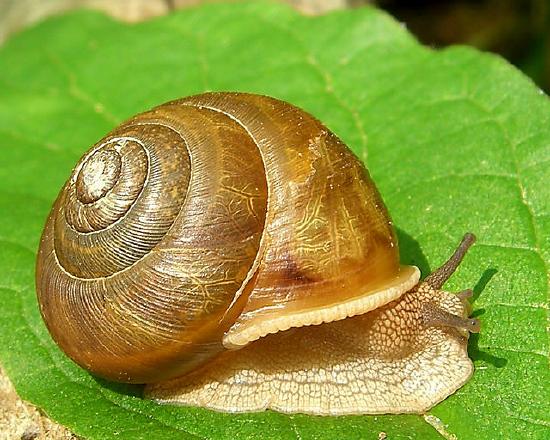
Is an insect an animal?
Of course it is. Is a snail an insect? No, snails are mollusks. Notice the large "foot" that allows movement, and the antennas are obvious. Actually, a snail's eyes are on the two long projections on its head, and the projections are called eyestalks. These are characteristics of this animal.
Characteristics of Animals
Animals are a kingdom of multicellular eukaryotes. They cannot make their own food. Instead, they get nutrients by eating other living things. Therefore, animals are heterotrophs.
Animal Cells
Like the cells of all eukaryotes, animal cells have a nucleus and other membrane-bound organelles (see Figure below). Unlike the cells of plants and fungi, animal cells lack a cell wall. This gives animal cells flexibility. It lets them take on different shapes so they can become specialized to do particular jobs. The human nerve cell shown in Figure below is a good example. Its shape suits its function of transmitting nerve impulses over long distances. A nerve cell would be unable to take this shape if it were surrounded by a rigid cell wall.
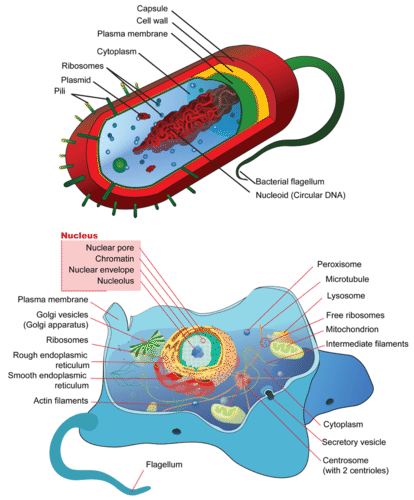 Animal Cell. The shape of an animal cell is not constrained by a rigid cell wall. A bacterial cell is shown above for comparison.
Animal Cell. The shape of an animal cell is not constrained by a rigid cell wall. A bacterial cell is shown above for comparison. Human Nerve Cell. A human nerve cell is specialized to transmit nerve impulses. How do you think the cell’s shape helps it perform this function?
Human Nerve Cell. A human nerve cell is specialized to transmit nerve impulses. How do you think the cell’s shape helps it perform this function?Animal Structure and Function
Animals not only have specialized cells. Most animals also have tissues and organs. In many animals, organs form organ systems, such as a nervous system. Higher levels of organization allow animals to perform many complex functions. What can animals do that most other living things cannot? Most animals share these characteristics: sensory organs, movement, and internal digestion. All of them are illustrated in Figure below.
- Animals can detect environmental stimuli, such as light, sound, and touch. Stimuli are detected by sensory nerve cells. The information is transmitted and processed by the nervous system. The nervous system, in turn, may direct the body to respond.
- All animals can move, at least during some stage of their life cycle. Muscles and nerves work together to allow movement. Being able to move lets animals actively search for food and mates. It also helps them escape from predators.
- Virtually all animals have internal digestion of food. Animals consume other organisms and may use special tissues and organs to digest them. (Many other organisms absorb nutrients directly from the environment.)
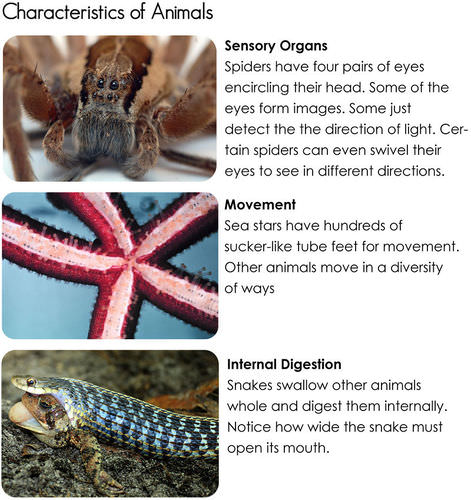 Most animals share these characteristics: sensory organs, movement, and internal digestion.
Most animals share these characteristics: sensory organs, movement, and internal digestion.Animal Life Cycle and Reproduction
Many animals have a relatively simple life cycle. A general animal life cycle is shown in Figure below. Most animals spend the majority of their life as diploid organisms. Just about all animals reproduce sexually. Diploid adults undergo meiosis to produce sperm or eggs. Fertilization occurs when a sperm and an egg fuse. The zygote that forms develops into an embryo. The embryo eventually develops into an adult.
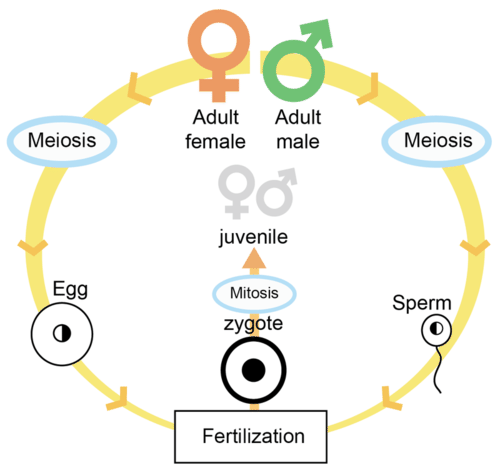 Animal Life Cycle. An animal life cycle that includes only sexual reproduction is shown here. Some animals also reproduce asexually. How does the animal life cycle compare with the life cycle of a plant?
Animal Life Cycle. An animal life cycle that includes only sexual reproduction is shown here. Some animals also reproduce asexually. How does the animal life cycle compare with the life cycle of a plant?Summary
- Animals are multicellular eukaryotes that lack cell walls.
- All animals are heterotrophs.
- Animals have sensory organs, the ability to move, and internal digestion. They also have sexual reproduction.
Review
- Identify traits that characterize all animals.
- State one way that animal cells differ from the cells of plants and fungi. What is the significance of this difference?
- Describe animal digestion.
- Describe a general animal life cycle.
| Image | Reference | Attributions |
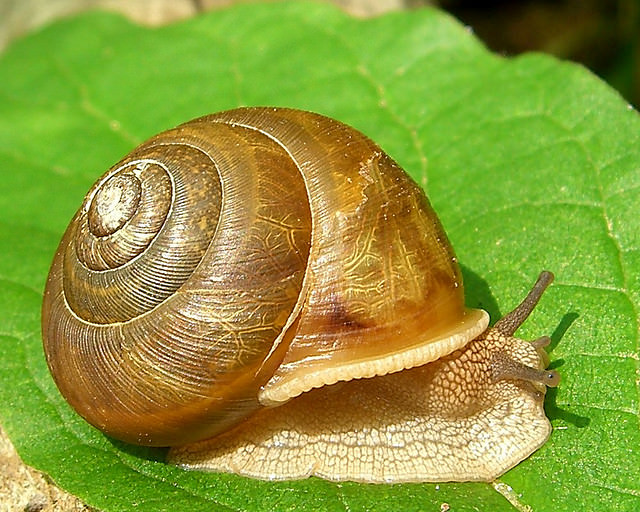 |
[Figure 1] | Credit: Top to bottom: Bryce McQuillan; Dr. James P. McVey, NOAA Sea Grant Program; Scott Oves Source: Top to bottom: www.flickr.com/photos/spidermanbryce2006/1802722621/ ; www.photolib.noaa.gov/htmls/reef0206.htm ; http://www.flickr.com/photos/silicon640c/5968047195/ License: Top to bottom CC BY 2.0; Public Domain; CC BY 2.0 |
 |
[Figure 2] | Credit: Mariana Ruiz Villarreal (User:LadyofHats/Wikimedia Commons) Source: Top: commons.wikimedia.org/wiki/File:Average_prokaryote_cell-_en.svg ; Bottom: commons.wikimedia.org/wiki/File:Animal_cell_structure_en.svg License: Public Domain |
 |
[Figure 3] | Credit: Top to bottom: Bryce McQuillan; Dr. James P. McVey, NOAA Sea Grant Program; Scott Oves Source: Top to bottom: www.flickr.com/photos/spidermanbryce2006/1802722621/ ; www.photolib.noaa.gov/htmls/reef0206.htm ; http://www.flickr.com/photos/silicon640c/5968047195/ License: CC BY-NC-SA 3.0; Top: CC BY 2.0; Middle: Public Domain; Bottom: CC BY 2.0 |
 |
[Figure 4] | Credit: Top to bottom: Bryce McQuillan; Dr. James P. McVey, NOAA Sea Grant Program; Scott Oves Source: Top to bottom: www.flickr.com/photos/spidermanbryce2006/1802722621/ ; www.photolib.noaa.gov/htmls/reef0206.htm ; http://www.flickr.com/photos/silicon640c/5968047195/ License: Top to bottom CC BY 2.0; Public Domain; CC BY 2.0 |
 |
[Figure 5] | Credit: Mariana Ruiz Villarreal (LadyofHats) for CK-12 Foundation Source: CK-12 Foundation License: CC BY-NC 3.0 |

